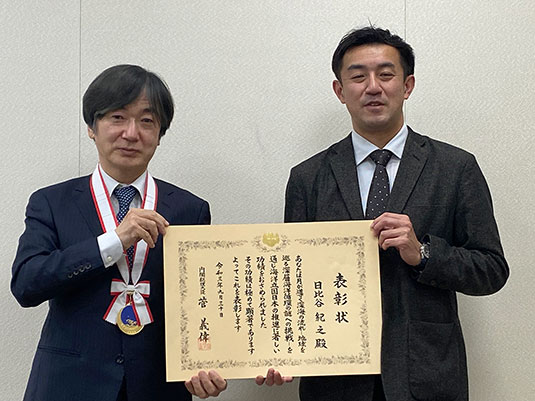DATE2021.12.02 #Awards & Prizes
Professor Noriyuki Hibiya receives the 14th Prime Minister's Commendation for his contribution to the promotion of a maritime nation.
Disclaimer: machine translated by DeepL which may contain errors.
Professor Noriyuki Hibiya of the Department of Earth and Planetary Science has received the Prime Minister's Commendation for the Promotion of a Nation of Oceans, an award given to individuals and organizations that have made outstanding achievements in ocean-related science and research.
Professor Hibiya has long been engaged in research to elucidate and quantify the physical mechanisms of deep-sea turbulence, which is indispensable for understanding the deep ocean circulation that influences long-term climate change. In the 1990s, when there were no deep-sea turbulence meters in Japan, numerical experiments showed for the first time that near-inertial internal waves with high vertical wavenumber are formed near ocean ridges and seamounts located at 20˚ to 30˚ latitude through parameter resonance with internal ocean tidal waves with low vertical wavenumber and half-day cycle, and that the associated near-inertial flow shear excites strong deep-sea turbulence. This is the first theoretical prediction of strong deep-sea turbulence excited by the accompanying near-inertial flow shear. Based on this theoretical result, he has confirmed the existence of latitudinal dependence of deep-sea turbulence intensity through observations in various ocean regions and completed the world's first global mapping of turbulence intensity in the middle and deep layers of the ocean. While clearly denying the involvement of wind stress, which has been regarded as a major energy source of deep-sea turbulence along with tides, he theoretically clarified that when the amplitude of tidal currents passing over rough seafloor topography increases, turbulent hot spots spread significantly vertically upward due to the breaking of internal downwind waves propagating from the seafloor. This new source of turbulent energy has been discovered. By discovering this new source of turbulent energy, he demonstrated once again that the deep ocean circulation is strongly controlled by the existence of tides, or "moons," which are the main source of energy for deep-sea turbulence. Furthermore, based on the observations by the deep-sea turbulence meter, he has been improving the turbulence parameterization, and in particular, he has newly constructed the Ijichi-Hibiya parameterization that accurately predicts turbulence intensity in the middle and deep layers of the ocean.

Professor Hibiya with Mr. Odoi, Manager, Ocean and Earth Division, MEXT, at MEXT
These groundbreaking research results on understanding the actual conditions and physical mechanisms of deep-sea turbulence have attracted attention as they have dramatically advanced turbulence research in Japan, which had lagged behind Europe and the United States, and have significantly contributed to the improvement of the accuracy of deep ocean circulation models and, by extension, the accuracy of climate change predictions.
We would like to extend our sincere congratulations on receiving this award and wish him continued success in his future endeavors.
The 14th Prime Minister's Commendation for the Promotion of Maritime Nation
https://www.mlit.go.jp/report/press/kaiji01_hh_000524.html
(Responsibility: Professor Juno Masumoto, Department of Earth and Planetary Science)


